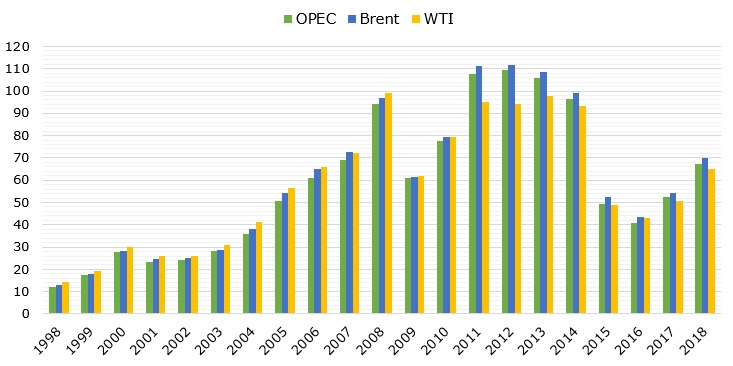Oil Market: Key Facts on Top 5 Producing Countries
28 Jun 2018 • by Natalie Aster

LONDON – Despite multiple attempts made to spur the development of the renewable energy sector, the significance of oil is undeniable. It is a considerable revenue generator for nations lucky enough to possess oil reserves and output more than their domestic demand. From the other side, it is a huge category of expenditures for those nations which are strongly dependent on oil imports. At present, the world’s oil market is experiencing big changes triggered by such factors as novel oil field discoveries, unrest in some oil-producing regions, and ongoing advancements in extraction technologies, amid others.
As of 2016, the world’s average volume of oil production totaled around 92.02 million barrels per day. In 2017, it climbed to 92.64 million barrels per day, demonstrating a sluggish YoY increase.
Worldwide oil production during 1998-2017 (in million barrels per day)
.jpg)
During the last several years, news about the global crude oil plunge has been taking the centre stage. The downward trend in crude oil prices started approximately in the middle of 2014 and bottomed out in January-2016 reaching the lowest level for above a decade. The uncertain economic situation across the globe also resulted in a falling global consumption of and demand for oil. However, major oil-producing countries continued to output even though prices kept decreasing in order to maintain their precious market shares in the oil sector.
To cope with oversaturation and push up prices, an agreement between the leading producing countries to freeze the oil production, initiated by Saudi Arabia and Russia, was finally adopted at the end of November 2016. This deal caused the global oil prices to recover and take the upward trend during late 2016 and in 2017. It was later extended till December 2018 with global oil prices picking up steadily.
In Q4 2018, WTI crude oil prices are projected to average USD 59.6 per barrel, whilst Bret crude oil prices will likely average USD 63.1 per barrel.
Average annual crude oil prices during 1998-2018* (in USD per barrel)
The 5 leading oil-producing countries contributed about 50% of the world’s total production volume. Below is an outlook for the top 5 oil-producing nations.
5. CHINA
With a share of nearly 4.8% in global oil output, China holds the 5th spot on the world’s oil arena. In 2017, the Chinese average oil production volume declined by 84,000 barrels per day and totaled slightly over 4.77 million barrels per day. Approximately 80% of the domestic oil production capacity is onshore, whilst the remaining 20% come from shallow offshore reserves. Besides, China is the global 2nd-biggest consumer of oil and the top net importer of this commodity.
The north central and northeast regions of China contribute the bulk share of the domestic oil output. Companies active in mature fields in these regions make investments in enhanced oil recovery (EOR) techniques (e.g., steam and polymer flooding and water injection) in order to offset some declines of the domestic production. China is also increasing its focus on the development of new offshore options.
China’s average oil production during 2004-2017 (in million barrels per day)
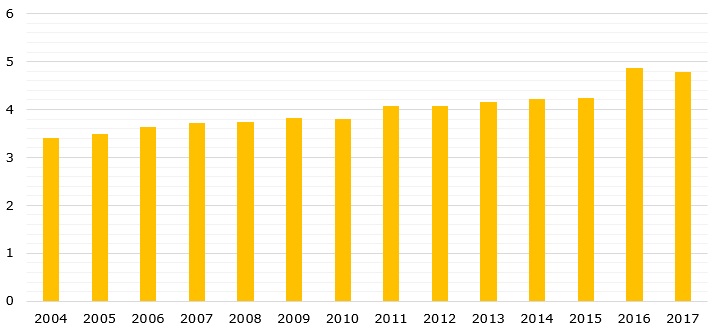
Today, the largest portion of oil imports to China comes from Iran, however, the US sanctions will probably have a negative effect on supply from this country in the short run. Therefore, China will likely be forced to find some other suppliers or arm up the domestic production to fill the gap.
Despite the modest reserves (appr. 20.35 billion barrels), the Chinese oil industry is slated to keep on rising in the coming years, spurred by the rapidly-growing national economy, constantly mounting energy demand and implementation of advanced technologies.
4. CANADA
Canada comes in fourth in the worldwide oil production race with the average output volume of slightly over 4.8 million barrels per day, capturing around 5.2% of the total oil production in the world. Presently, the country’s main oil sources are the oil sands of the Western Canada Sedimentary Basin, Atlantic offshore fields, and Alberta. The Canadian oil sector is privatised with numerous foreign and domestic players active in the country’s oil market.
Canada’s average oil production and exports during 2004-2017 (in million barrels per day)
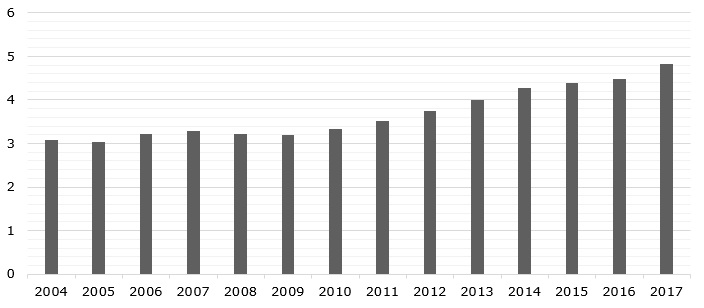
To date, the USA captures the major share of the Canadian oil exports. But the situation may change in the offing, as Canada is making attempts to diversify its trading partners, for instance, it is expanding ties with developing countries of the Asian region.
By the year 2040, the Canadian average oil output is anticipated to gain around 1.26 million barrels per day, propelled majorly by the uptick in the oil sands production – one of the cheapest ways of crude oil extraction. Moreover, expanding adoption of innovative technologies in the national oil sector will help to cut down the production costs.
3. RUSSIA
Although Russia has fallen in the global ranks, it remains in the list of the leading oil producers holding the third place. The country’s share in the world’s average output is equal to 12.2%. In 2016, the country’s average output volume increased by around 260,000 barrels per day and reached almost 11.27 million barrels per day. However, in 2017 it witnessed a modest decline and stood at slightly above 11.25 million barrels per day.
Russia’s average oil production during 2004-2017 (in million barrels per day)
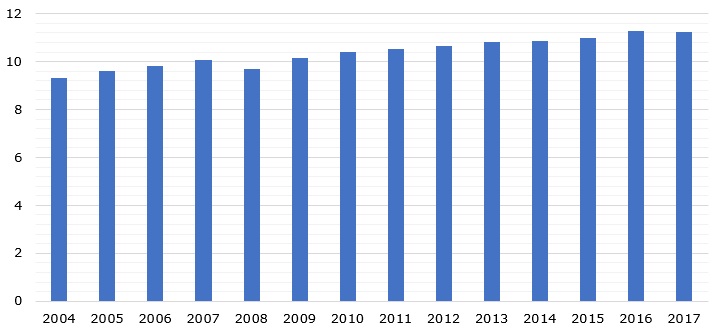
Russia has the eights biggest oil reserves worldwide. The major oil-producing regions in the country include Volga-Ural, Western Siberia, Sakhalin, Krasnoyarsk, Komi Republic, Irkutsk Arkhangelsk, and Yakutiya. Although after the demise of the Soviet Union Russia’s oil industry was privatised, the market players were reverted to government control after a few years.
Russia is also amid the world’s leading exporters of oil. In the year 2016, the nation’s crude oil exports stood at over 5.2 million barrels per day. European countries are the key destinations of Russia’s oil exports.
2. SAUDI ARABIA
Contributing approximately 12.9% to the global oil output, Saudi Arabia is at number two position in the list of world’s dominant oil producers. This country boasts rich oil reserves (260 billion barrels) and ranks the top petroleum exporter in the world. The largest oil fields comprise Safaniya, Ghawar, Khurais, Shaybah, Manifa, Khursaniyah, Qatif, Abqaiq, and Zuluf.
As of 2016, the Saudi Arabian average oil production witnessed a remarkable increase and surpassed 12.4 billion barrels per day. However, in 2017 the country’s production volume decreased to appr. 11.95 barrels per day.
Saudi Arabia’s average oil production during 2004-2017 (in million barrels per day)
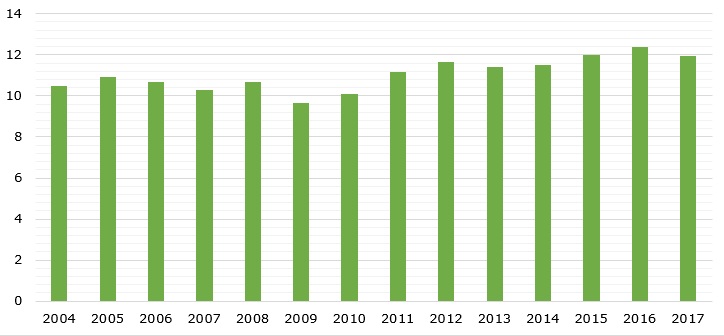
Despite continuous attempts of Saudi Arabia’s government to diversify the national economy, it still remains heavily reliant on oil. Presently, the petroleum industry accounts for nearly 87% of the total budget revenues, 42% of the country’s GDP, and 90% of the earnings generated from exports.
Saudi Arabia played an essential role in OPEC’s decision to cut oil production in late 2016.
1. THE USA
The USA is the number one on the list of the dominating oil-producing nations. Its average oil output climbed to 13.05 billion barrels per day in 2017, which is equivalent to nearly 14.1% of the world’s total production. The USA outpaced Russia in the year 2012 to become the 2nd biggest producer, and overtook the former leader, Saudi Arabia, in 2013 for the № 2 spot. The key factors that allowed the USA to mount to the top position are restraints on oil output abroad and fast-growing national economy. Much of the USA production gains are attributed to the booming share sector in North Dakota and Texas.
The USA average oil production during 2004-2017 (in million barrels per day)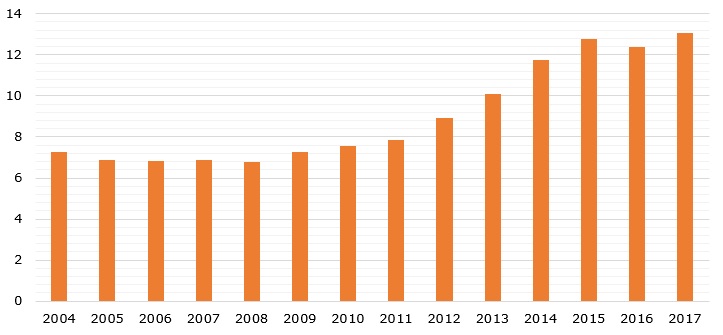
The USA is recognised as a swing producer as the local production fluctuates along with market prices. The country is set to continue satiating the mushrooming global appetite for oil with the domestic oil production anticipated to surge through 2019 and reach a new record high.
Conclusion
Undoubtedly, energy is of paramount importance in people’s life and human progress. This is true at the moment and will remain true in future. Despite the rapidly-evolving renewables sector, oil still remains the leading fuel in the world, responsible for around a third of the world’s energy consumption.
© MarketPublishers.com, 2018
Analytics & News

